Temporal and Spatial Changes of Agriculture Green Development in Beijing’s Ecological Conservation Developing Areas from 2006 to 2016
Abstract
:1. Introduction
2. Literature Review
2.1. AGD Evaluation Indicator Framework
2.2. AGD Evaluation Methods
3. Materials and Methods
3.1. Study Area and Data
3.2. AGD Evaluation Method—Projection Pursuit Method
3.3. Obstacle-Degree-Calculating Model
4. Results and Analysis
4.1. AGD Evaluation Indicator Framework for Beijing ECDA
4.2. Weight of Integrated Evaluation
4.3. Green Agricultural Production
4.4. Green Agricultural Revenue
4.5. Temporal and Spatial Variations of AGD in Beijing’s ECDA
4.6. Key Limiting Factors of AGD in ECDA
5. Discussion
5.1. Effectiveness of the Selected AGD Indicators and Evaluation Method in Beijing
5.2. Heterogeneous Spatial and Temporal Characteristics of AGD in ECDA
5.3. Factors Influencing AGD Level
5.4. Measurements to Accelerate AGD Level
6. Conclusions
Supplementary Materials
Author Contributions
Funding
Data Availability Statement
Conflicts of Interest
References
- Gibbs, D.; Longhurst, J. Sustainable development and environmental technology: A comparison of policy in Japan and the European Union. Environmentalist 1995, 15, 196–201. [Google Scholar] [CrossRef]
- Su, Y.; Chen, X.; Liao, J.; Zhang, H.; Wang, C.; Ye, Y.; Wang, Y. Modeling the optimal ecological security pattern for guiding the urban constructed land expansions. Urban For. Urban Green. 2016, 19, 35–46. [Google Scholar] [CrossRef]
- Xie, H.; Yao, G.; Liu, G. Spatial evaluation of the ecological importance based on GIS for environmental management: A case study in Xingguo county of China. Ecol. Indic. 2015, 51, 3–12. [Google Scholar] [CrossRef]
- Sun, X.; Lu, Z.; Li, F.; Crittenden, J.C. Analyzing spatio-temporal changes and trade-offs to support the supply of multiple ecosystem services in Beijing, China. Ecol. Indic. 2018, 94, 117–129. [Google Scholar] [CrossRef]
- Holden, E.; Linnerud, K.; Banister, D. The imperatives of sustainable development. Sustain. Dev. 2017, 25, 213–226. [Google Scholar] [CrossRef]
- United Nations Environment Program (UNEP). Guidelines for AEO Cities Integrated Environmental Assessment and Report. 2005. Available online: https://www.unep.org/explore-topics/environment-under-review/what-we-do/environmental-assessment/guidelines-conducting (accessed on 12 December 2023).
- United Nations Environment Program (UNEP). Green Economy: Cities Investing in Energy and Resource Efficiency. 2011. Available online: https://wedocs.unep.org/handle/20.500.11822/7979 (accessed on 12 December 2023).
- Wang, X.; Song, C.; Cheng, C.; Ye, S.; Shen, S. Cross-national perspectives on using sustainable development goals (SDGs) indicators for monitoring sustainable development: A database and analysis. Chin. Geogr. Sci. 2021, 31, 600–610. [Google Scholar] [CrossRef]
- United Nations. Goal 2: End Hunger, Achieve Food Security and Improved Nutrition and Promote Sustainable Agriculture; Metadata Repository; United Nations: New York, NY, USA, 2016. [Google Scholar]
- Bolcárová, P.; Kološta, S. Assessment of sustainable development in EU 27 using aggregated SD index. Ecol. Indic. 2015, 48, 699–705. [Google Scholar] [CrossRef]
- Cracolici, M.F.; Cuffaro, M.; Lacagnina, V. Assessment of sustainable well-being in the Italian regions: An activity analysis model. Ecol. Econ. 2018, 143, 105–110. [Google Scholar] [CrossRef]
- James, H.S. Sustainable agriculture and free market economics: Finding common ground in Adam Smith. Agric. Hum. Values 2006, 23, 427–438. [Google Scholar] [CrossRef]
- Pham, L.V.; Smith, C. Drivers of agricultural sustainability in developing countries: A review. Environ. Syst. Decis. 2014, 34, 326–341. [Google Scholar] [CrossRef]
- Ahmed, N.; Hamid, Z.; Mahboob, F.; Rehman, K.U.; Ali, M.S.E.; Senkus, P.; Wysokinska-Senkus, A.; Sieminski, P.; Skrzypek, A. Causal linkage among agricultural insurance, air pollution, and agricultural green total factor productivity in United States: Pairwise granger causality approach. Agriculture 2022, 12, 1320. [Google Scholar] [CrossRef]
- BenJebli, M.; BenYoussef, S. Renewable energy consumption and agriculture: Evidence for cointegration and granger causality for tunisian economy. Int. J. Sustain. Dev. World Ecol. 2017, 24, 149–158. [Google Scholar] [CrossRef]
- Bare, J.C. Development of impact assessment methodologies for environmental sustainability. Clean Technol. Environ. Policy 2014, 16, 681–690. [Google Scholar] [CrossRef]
- Janker, J. Moral conflicts, premises and the social dimension of agricultural sustainability. Agric. Hum. Values 2020, 37, 97–111. [Google Scholar] [CrossRef]
- Laurett, R.; Paco, A.; Mainardes, E.W. Sustainable Development in Agriculture and its Antecedents, Barriers and Consequences-An Exploratory Study. Sustain. Prod. Consum. 2021, 27, 298–311. [Google Scholar] [CrossRef]
- Kansanga, M.; Andersen, P.; Kpienbaareh, D.; Mason-Renton, S.; Atuoye, K.; Sano, Y.; Antabe, R.; Luginaah, I. Traditional agriculture in transition: Examining the impacts of agricultural modernization on smallholder farming in Ghana under the new Green Revolution. Int. J. Sustain. Dev. World Ecol. 2019, 26, 11–24. [Google Scholar] [CrossRef]
- Horlings, L.G.; Marsden, T.K. Towards the real green revolution? Exploring the conceptual dimensions of a new ecological modernisation of agriculture that could ‘feed the world’. Glob. Environ. Chang. 2011, 21, 441–452. [Google Scholar] [CrossRef]
- Koohafkan, P.; Altieri, M.A.; Eric, H.G. Green agriculture: Foundations for biodiverse, resilient and productive agricultural systems. Int. J. Agric. Sustain. 2012, 10, 61–75. [Google Scholar] [CrossRef]
- Zhou, F.; Wen, C. Research on the level of agricultural green development, regional disparities, and dynamic distribution evolution in China from the perspective of sustainable development. Agriculture 2023, 13, 1441. [Google Scholar] [CrossRef]
- Liu, Y.; Sun, D.; Wang, H.; Wang, X.; Yu, G.; Zhao, X. An evaluation of China’s agricultural green production: 1978–2017. J. Clean. Prod. 2020, 243, 118483. [Google Scholar] [CrossRef]
- Zhou, S.; Zhang, N.; Zhang, X. Metro construction risk assessment based on PPC-D-S evidence theory. Mod. Tunn. Technol. 2021, 58, 75–83. [Google Scholar]
- Ma, L.; Bai, Z.; Ma, W.; Guo, M.; Jiang, R.; Liu, J.; Oenema, O.; Velthof, G.L.; Whitmore, A.P.; Crawford, J.; et al. Exploring future food provision scenarios for China. Environ. Sci. Technol. 2019, 53, 1385–1393. [Google Scholar] [CrossRef] [PubMed]
- The Ministry of Agriculture and Rural Affairs (MARA). National Plan for Green Agricultural Development during the 14th Five-Year. 2021. Available online: http://www.gov.cn/zhengce/zhengceku/2021-09/07/5635867/files/737ff96c0cc74f788394eb6194cc44c6.pdf (accessed on 8 May 2023).
- Yu, X. Promoting Agriculture Green Development to realize the great rejuvenation of the Chinese nation. Front. Agric. Sci. Eng. 2020, 7, 112–113. [Google Scholar]
- Zhou, X.; Li, X. Analysis of spatial heterogeneity of green agricultural production level: Based on empirical data of Shandong province from 2010 to 2019. Rev. Econ. Manag. 2021, 37, 152–164. [Google Scholar]
- Wang, X.; Lv, J. The comprehensive evaluation of agricultural green development level and analysis of its obstacle factors in Gansu Province. Terri. Nat. Resour. Stud. 2022, 22, 69–73. [Google Scholar]
- Li, X.; Li, J. Evaluation of agricultural green development level in Henan Province based on close value method. Shanxi Agric. Econ. 2022, 14, 22–24. [Google Scholar]
- Zhang, W.; Duan, L. Identification of driving factors and performance evaluation of Zhejiang agricultural green development. Chin. J. Agric. Resour. Region. Plan. 2022, 43, 24–33. [Google Scholar]
- Kuang, A.; Yue, Y.; Cao, S. Comprehensive evaluation of green agricultural development level in Guangxi. J. Guangxi Agric. 2022, 37, 37–43. [Google Scholar]
- Li, F.; Zhou, X.; Zhou, Y. Evaluation and regional difference analysis of agricultural green development level in Bohai Rim Region. J. Agric. Resour. Region. Plan. 2023, 44, 118–129. [Google Scholar]
- Zha, J.; Zhou, X.; Zhou, Y. Evaluation of agricultural green development level in the Yellow river. Chin. J. Agric. Resour. Region. Plan. 2022, 1, 18–28. [Google Scholar]
- Zhou, J. Evaluation, regional difference analysis and optimization path of agricultural green development in Yangtze River Economic Belt. Rural Econ. 2021, 12, 99–108. [Google Scholar]
- Liu, J.; Liu, X. Study on measurement and enhancement path of the level of the agricultural green development: An empirical example from 11 Cities in the Pearl River-West River economic belt. Ecol. Econ. 2022, 38, 100–107. [Google Scholar]
- Nandy, S.; Singh, C.; Das, K.K.; Kingma, N.C.; Kushwaha, S.P.S. Environmental vulnerability assessment of eco-development zone of Great Himalayan National Park, Himachal Pradesh, India. Ecol. Indic. 2015, 57, 182–195. [Google Scholar] [CrossRef]
- Gargano, G.; Licciardo, F.; Verrascina, M.; Zanetti, B. The agroecological approach as a model for multifunctional agriculture and farming towards the European Green Deal 2030-some evidence from the Italian experience. Sustainability 2021, 13, 2215. [Google Scholar] [CrossRef]
- Yang, Z.C.; Zhou, L.D.; Sun, D.F.; Li, H.; Yu, M. Proposal for developing carbon sequestration economy in ecological conservation area of Beijing. Adv. Mater. Res. 2012, 524, 3424–3427. [Google Scholar] [CrossRef]
- Xu, J.; Wang, J.; Xiong, N.; Chen, Y.; Sun, L.; Wang, Y.; An, L. Analysis of ecological blockage pattern in Beijing important ecological function area, China. Remote Sens. 2022, 14, 1151. [Google Scholar] [CrossRef]
- Jogo, W.; Hassan, R. Balancing the use of wetlands for economic well-being and ecological security: The case of the Limpopo wetland in southern Africa. Ecol. Econ. 2010, 69, 1569–1579. [Google Scholar] [CrossRef]
- Liu, C.L.; Chen, M.X.; Tang, Z.P.; Liu, W.; Lu, D.; Zhang, Y. The “valley economy” model of regional development: A case study of mountain areas in Beijing, Northern China. J. Mt. Sci. 2014, 11, 1372–1382. [Google Scholar] [CrossRef]
- Zhang, Y. Evaluation and spatial difference of agricultural green development level in the Yellow River basin based on entropy weight-TOPSIS. Hubei Agric. Sci. 2022, 61, 230–236. [Google Scholar]
- Tang, C.; Wu, X.; Zheng, Q.; Ning, L. Ecological security evaluations of the tourism industry in ecological conservation development areas: A case study of Beijing’s ECDA. J. Clean. Prod. 2018, 197, 999–1010. [Google Scholar] [CrossRef]
- Guo, J.; Huang, Y. Construction and empirical analysis of evaluation indicator system of agricultural green development in Beijing-Tianjin-Hebei region. Agric. Outlook 2022, 18, 50–56. [Google Scholar]
- Song, Y.; Yang, P.; Zheng, S. Evaluation of green development level of agriculture in Yangtze River Delta. J. Anhui Univ. Sci. Tech. 2022, 24, 11–17. [Google Scholar]
- Dou, Y.; Zhao, G.; Jiang, Y. Comprehensive evaluation of the green development level of agriculture in Tianjin. J. Chin. Agric. Mech. 2021, 42, 159–165. [Google Scholar]
- Li, Y.; Zhang, J.; Cui, S.; Ma, L.; Ma, W.; Wei, J. Temporal and spatial characteristics of agricultural green development indicators in counties of Hebei Province. Chin. J. Eco-Agric. 2020, 28, 1168–1180. [Google Scholar]
- Song, C.; Zhang, J.; Liu, L.; Ma, W.; Ma, L.; Ding, S.; Zhao, H. Spatial and temporal characteristics of agricultural green development indicators in Hainan Island. Chin. J. Eco-Agri. 2020, 28, 1156–1167. [Google Scholar]
- Yin, C.; Li, F.; Wang, S.; Hao, A. The concept, connotation and principle of agricultural green development in China. Chin. J. Agri. Resour. Reg. Plan. 2021, 1, 1–6. [Google Scholar]
- Zhang, Y.; Liu, L. The influence of the Sci-Tech finance ecosystem on technological innovation from symbiotic perspective. Syst. Eng. 2021, 39, 25–36. [Google Scholar]
- Zhang, Y.; Mu, L.; Zhao, Y. Research on evaluation and countermeasures of regional green industry development. Ecol. Econ. 2017, 33, 41–44. [Google Scholar]
- Gai, M.; Yang, Q.; He, Y. Spatiotemporal changes and influencing factors of agricultural green development level in main grain producing areas in Northeast China. Resour. Sci. 2022, 44, 927–942. [Google Scholar] [CrossRef]
- Li, J.; Huang, X.; Yang, T.; Su, M.; Guo, L. Reducing the carbon emission from agricultural production in China: Do land transfer and urbanization matter? Environ. Sci. Pollut. Res. 2023, 30, 68339–68355. [Google Scholar] [CrossRef]
- Li, S.; Wang, Z. The effects of agricultural technology progress on agricultural carbon emission and carbon sink in China. Agriculture 2023, 13, 793. [Google Scholar] [CrossRef]
- Shi, H.; Chang, M. How does agricultural industrial structure upgrading affect agricultural carbon emissions? Threshold effects analysis for China. Environ. Sci. Pollut. Res. 2023, 30, 52943–52957. [Google Scholar] [CrossRef] [PubMed]
- Wang, R.; Zhang, Y.; Zou, C. How does agricultural specialization affect carbon emissions in China? J. Clean. Prod. 2022, 370, 133463. [Google Scholar] [CrossRef]
- Saghaian, S.; Mohammadi, H.; Mohammadi, M. The effects of agricultural product exports on environmental quality. Sustainability 2022, 14, 13857. [Google Scholar] [CrossRef]
- Weinzettel, J.; Wood, R. Environmental footprints of agriculture embodied in international trade: Sensitivity of Harvested area footprint of Chinese exports. Ecol. Econ. 2018, 145, 323–330. [Google Scholar] [CrossRef]
- Xiong, Y.; Liu, Q.; Hu, X. Evaluation of agricultural green development in main grain producing counties of Sichuan Province. Agric. Outlook 2022, 18, 46–52. [Google Scholar]
- Hou, X.; Li, H.; Wang, Y.; Feng, G.; Liu, Y.; Li, X.; Gao, Q. Time variation characteristics of county agricultural green development index in Jilin Province-take Lishu County as an example. Chin. J. Eco-Agric. 2022, 31, 807–819. [Google Scholar]
- Shen, S.; Wang, L. Study on agricultural green development efficiency and influencing factors based on unexpected output model-taking 11 cities in Hebei Province as an example. Innov. Sci. Tech. 2021, 21, 80–88. [Google Scholar]
- Yang, J. Construction and empirical research on county agricultural green development index—Based on county cross-sectional data of Hubei Province in 2017. Jiangsu Agric. Sci. 2021, 49, 24–30. [Google Scholar]
- Duan, C.; Yu, C.; Li, S.; Zhong, Z.; He, Y. A comprehensive assessment of agricultural green development at the county level on the Tibetan plateau-a case study in Bailang County. Chin. J. Agric. Resour. Reg. Plan. 2023, 44, 82–90. [Google Scholar]
- Quiroga, S.; Suárez, C.; Fernández-Haddad, Z.; Philippidis, G. Levelling the playing field for European Union agriculture: Does the common agricultural policy impact homogeneously on farm productivity and efficiency? Land Use Policy 2017, 68, 179–188. [Google Scholar] [CrossRef]
- Neogi, D. Performance appraisal of select nations in mitigation of COVID-19 pandemic using entropy based TOPSIS method. Cien. Saude. Colet. 2021, 26, 1419–1428. [Google Scholar] [CrossRef] [PubMed]
- Wang, Z.; Wang, J.; Zhang, G.; Wang, Z. Evaluation of agricultural extension service for sustainable agricultural development using a hybrid entropy and TOPSIS method. Sustainability 2021, 13, 347. [Google Scholar] [CrossRef]
- Petridis, K.; Drogalas, G.; Zografidou, E. Internal auditor selection using a TOPSIS/nonlinear programming model. Ann. Oper. Res. 2021, 296, 513–539. [Google Scholar] [CrossRef]
- Bell, A.; Parkhurst, G.; Droppelmann, K.; Benton, T.G. Scaling uppro-environmental agricultural practice using agglomeration payments: Proof of concept from an agent-based model. Ecol. Econ. 2016, 126, 32–41. [Google Scholar] [CrossRef]
- Liu, J.; Li, Y.; Zheng, Y.; Tong, S.; Zhang, X.; Zhao, Y.; Zheng, W.; Zhai, B.; Wang, Z.; Zhang, X.; et al. The spatial and temporal distribution of nitrogen flow in the agricultural system and green development assessment of the Yellow River Basin. Agric. Water Manag. 2022, 263, 107425. [Google Scholar] [CrossRef]
- Veisi, H.; Liaghati, H.; Alipour, A. Developing anethics-based approach to indicators of sustainable agriculture using an alytichierarchy process(AHP). Ecol. Indicat. 2016, 60, 644–654. [Google Scholar] [CrossRef]
- Balezentis, T.; Li, T.; Chen, X. Has agricultural labor restructuring improved agricultural labor productivity in China? A decomposition approach. Socio-Econ. Plan. Sci. 2021, 76, 100967. [Google Scholar] [CrossRef]
- Yang, L.; Yang, Y. Evaluation of eco-efficiency in China from 1978 to 2016: Based on a modified ecological footprint model. Sci. Total Environ. 2019, 662, 581–590. [Google Scholar] [CrossRef]
- Bastan, M.; Ramazani Khorshid-Doust, R.; Delshad Sisi, S.; Ahmadvand, A. Sustainable development of agriculture: A system dynamics model. Kybernetes 2018, 47, 142–162. [Google Scholar] [CrossRef]
- Ahmad, N.; Qahmash, A. Implementing fuzzy AHP and FUCOM to evaluate critical success factors for sustained academic quality assurance and ABET accreditation. PLoS ONE 2020, 15, e0239140. [Google Scholar] [CrossRef] [PubMed]
- Li, L.; Wang, W. Spatial heterogeneity of manufacturing development quality in China: Analysis based on projection pursuit model. East China Econ. Manag. 2020, 34, 1–11. [Google Scholar]
- Li, Z. Projection pursuit technology (PPT) and its progress of application. Nat. Mag. 1997, 19, 224–227. [Google Scholar]
- Fu, Q.; Zhao, X. Principle and Application of Projection Pursuit Model; Science Press: Beijing, China, 2006. [Google Scholar]
- Lee, E.; Cook, D.; Klinke, S.; Lumley, T. Projection pursuit for exploratory supervised classification. J. Comput. Graph. Statist. 2005, 14, 831–846. [Google Scholar] [CrossRef]
- Grochowski, M.; Duch, W. Projection pursuit constructive neural networks based on quality of projected clusters. In International Conference on Artificial Neural Networks; Springer: Berlin/Heidelberg, Germany, 2008; pp. 754–762. [Google Scholar]
- Grear, T.; Avery, C.; Patterson, J.; Jacobs, D.J. Molecular function recognition by supervised projection pursuit machine learning. Sci. Rep. 2021, 11, 4247. [Google Scholar] [CrossRef]
- Qu, L.; Wang, Y.; Liu, Y.; Ma, Q. Evaluation of water and land resources system bearing capacity and path optimization for rural revitalization. J. Nat. Resour. 2021, 36, 300–314. [Google Scholar] [CrossRef]
- Jin, J.; Liu, D.; Zhou, R.; Zhang, L.; Cui, Y.; Wu, C. Evaluation model of water resources carrying capacity based on projection pursuit weight optimization. Water Resour. Prot. 2021, 3, 1–6. [Google Scholar]
- Wan, M.; Kuang, H.; Yang, Y.; He, B.; Zhao, S.; Wang, Y.; Huo, J. Evaluation of agricultural green development based on gini coefficient and hesitation fuzzy multi-attribute decision-making: The case of China. Agriculture 2023, 13, 699. [Google Scholar] [CrossRef]
- Ge, P.; Liu, T.; Wu, X.; Huang, X. Heterogenous urbanization and agricultural green development efficiency: Evidence from China. Sustainability 2023, 15, 5682. [Google Scholar] [CrossRef]
- Mei, B.; Khan, A.A.; Khan, S.U.; Ali, M.A.S.; Luo, J. An estimation of the effect of green financial policies and constraints on agriculture investment: Evidences of sustainable development achievement in northwest China. Front. Public Health 2022, 10, 903431. [Google Scholar] [CrossRef]
- Fang, L.; Hu, R.; Mao, H.; Chen, S. How crop insurance influences agricultural green total factor productivity: Evidence from Chinese farmers. J. Clean. Prod. 2021, 321, 128977. [Google Scholar] [CrossRef]
- Rani, P.S.; Mani, K.; Vidhyavathi, A. A study on agricultural credit in adoption of technology in banana cultivating farms in Tamil Nadu. Int. Res. J. Agric. Econ. Stat. 2019, 10, 194–200. [Google Scholar] [CrossRef]
- Lei, S.; Yang, X.; Qin, J. Does agricultural factor misallocation hinder agricultural green production efficiency? Evidence from China Journal. Sci. Total Environ. 2023, 891, 164466. [Google Scholar] [CrossRef] [PubMed]
- Hong, M.; Tian, M.; Wang, J. Digital inclusive finance, agricultural industrial structure optimization and agricultural green total factor productivity. Sustainability 2022, 14, 11450. [Google Scholar] [CrossRef]
- Hadi, A.; Suprihatin, H.; Pramuhadi, G. Exploring the sustainability dimensions of coffee agro-industry: A critical review and future research agenda. IOP Conf. Ser. Earth Environ. Sci. 2011, 1063, 012049. [Google Scholar] [CrossRef]
- Liu, Y.; Lu, C.; Chen, X. Dynamic analysis of agricultural green development efficiency in China: Spatiotemporal evolution and influencing factors. J. Arid Land 2023, 15, 127–144. [Google Scholar] [CrossRef]
- Joukhadar, I.S.; Walker, S.J.; Funk, P.A. Comparative mechanical harvest efficiency of six new Mexico pod–type green Chile pepper cultivars. HortTechnology 2018, 28, 310–318. [Google Scholar] [CrossRef]
- Zou, Y.; Cheng, Q.; Jin, H.; Pu, X. Evaluation of green agricultural development and its influencing factors under the framework of sustainable development goals: Case study of Lincang city, an underdeveloped mountainous region of China. Sustainability 2023, 15, 11918. [Google Scholar] [CrossRef]
- Du, Y.; Liu, H.; Huang, H.; Li, X. The carbon emission reduction effect of agricultural policy--evidence from China. J. Clean. Prod. 2023, 406, 137005. [Google Scholar] [CrossRef]
- Gao, Q.; Cheng, C.; Sun, G.; Li, J. The impact of digital Inclusive finance on agricultural green total factor productivity: Evidence from China. Front. Ecol. Evol. 2022, 10, 905644. [Google Scholar] [CrossRef]
- Hou, D.; Wang, X. Inhibition or promotion? The effect of agricultural insurance on agricultural green development. Front. Public Health 2022, 10, 910534. [Google Scholar] [CrossRef] [PubMed]
- Nadia, A.; Nordin, S.M.; Rahman, I.; Noor, A. The effects of knowledge transfer on farmers decision making toward sustainable agriculture practices: In view of green fertilizer technology. World J. Sci. Technol. Sust. Dev. 2018, 15, 98–115. [Google Scholar]
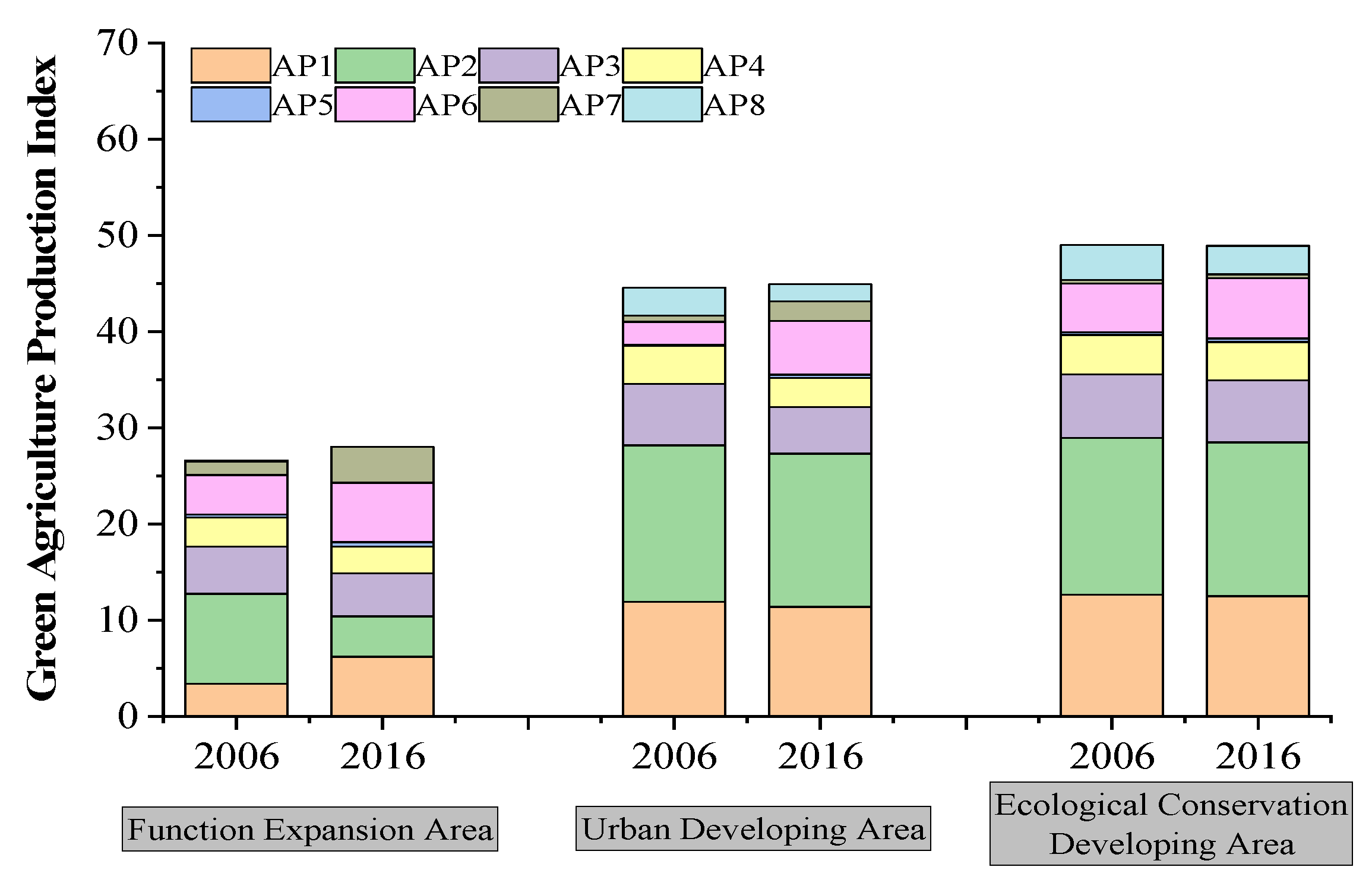
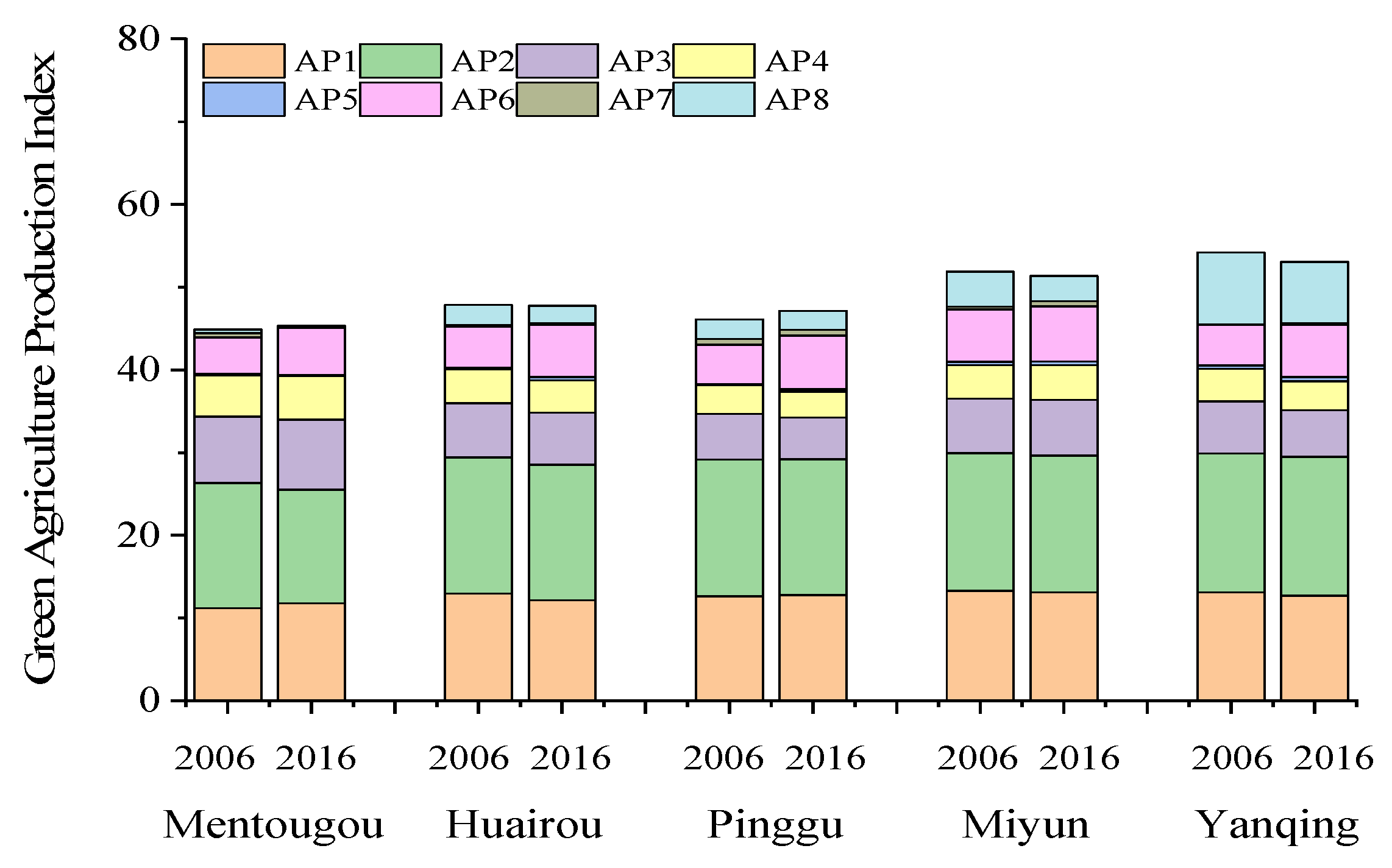
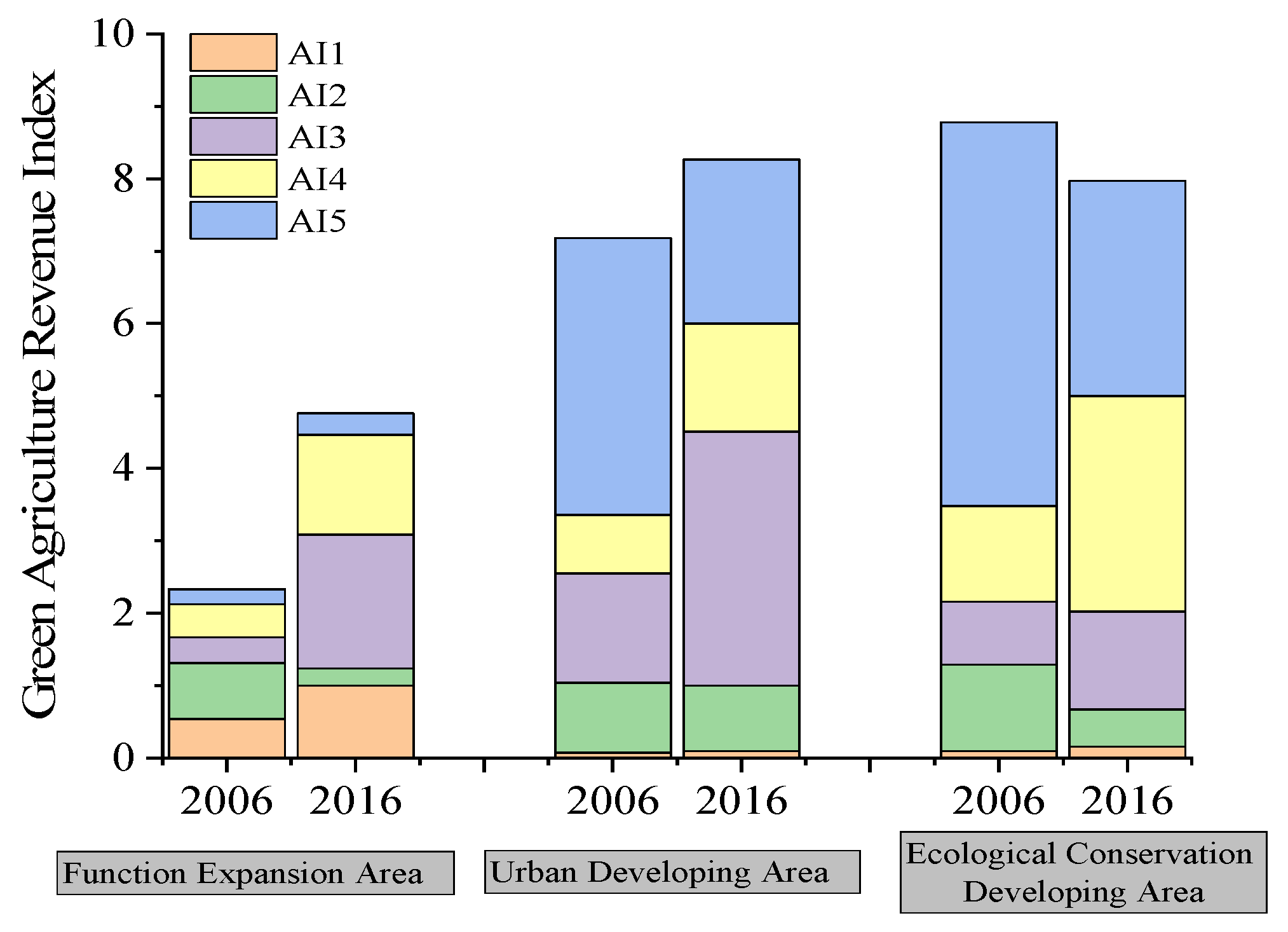
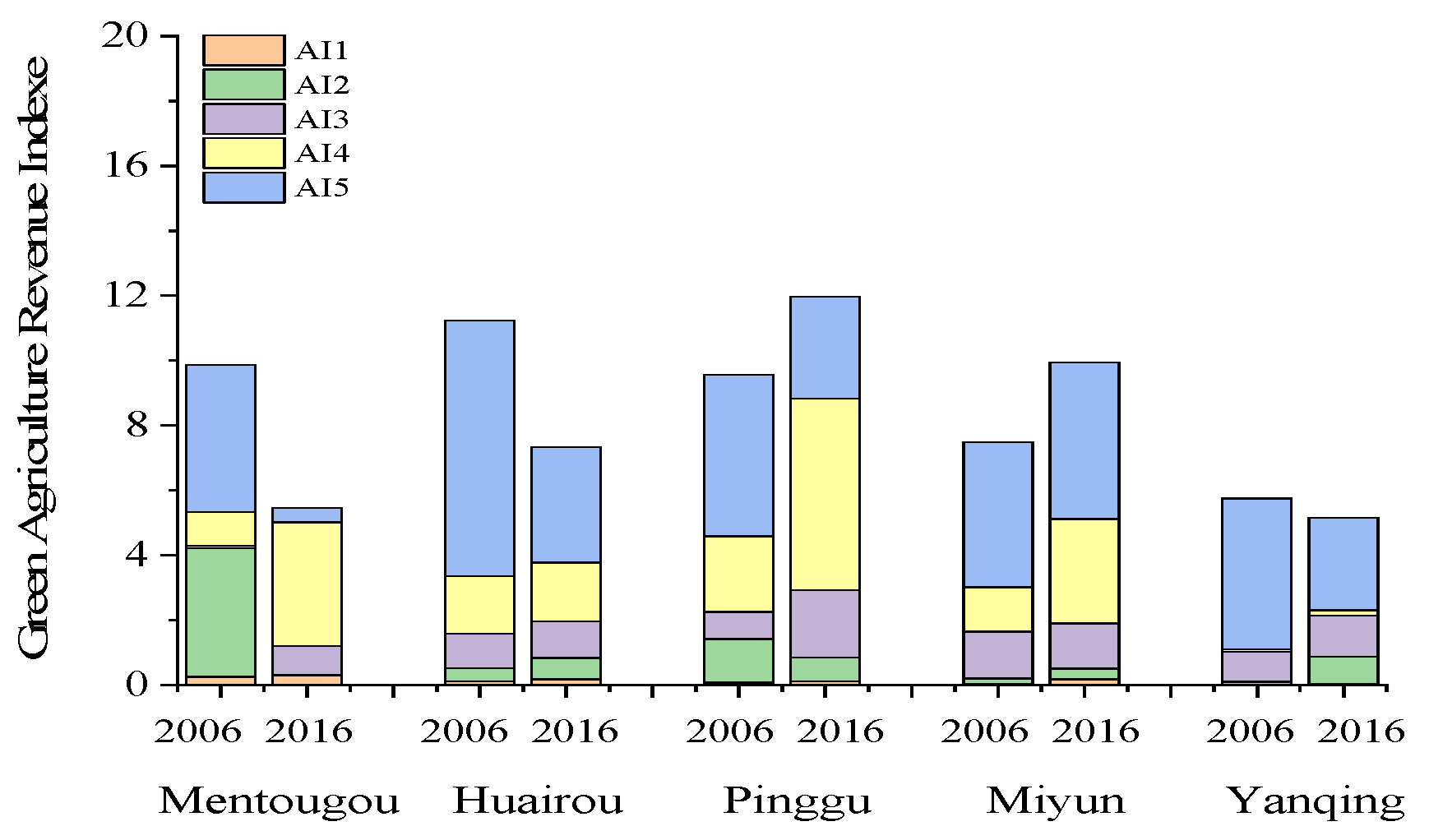
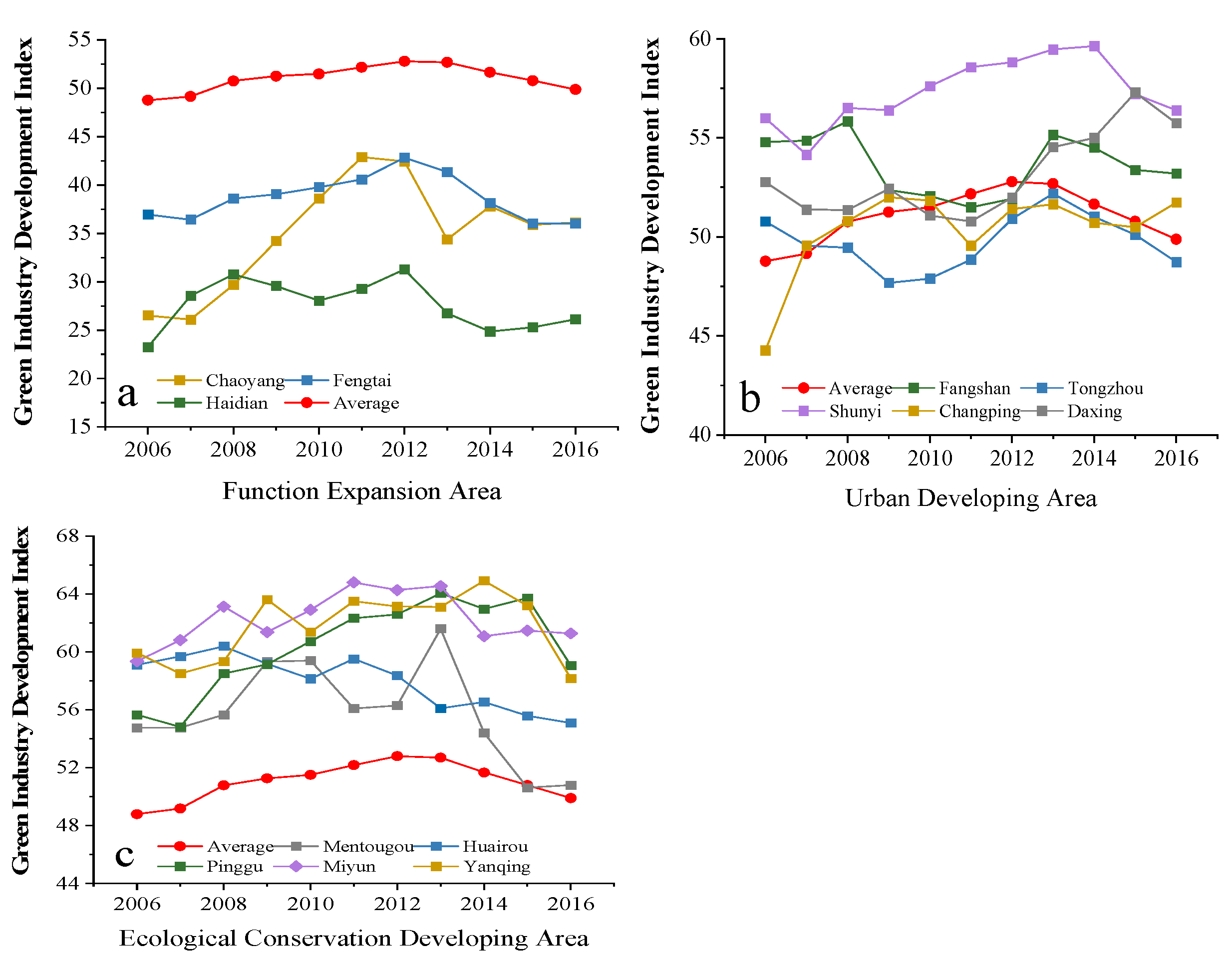
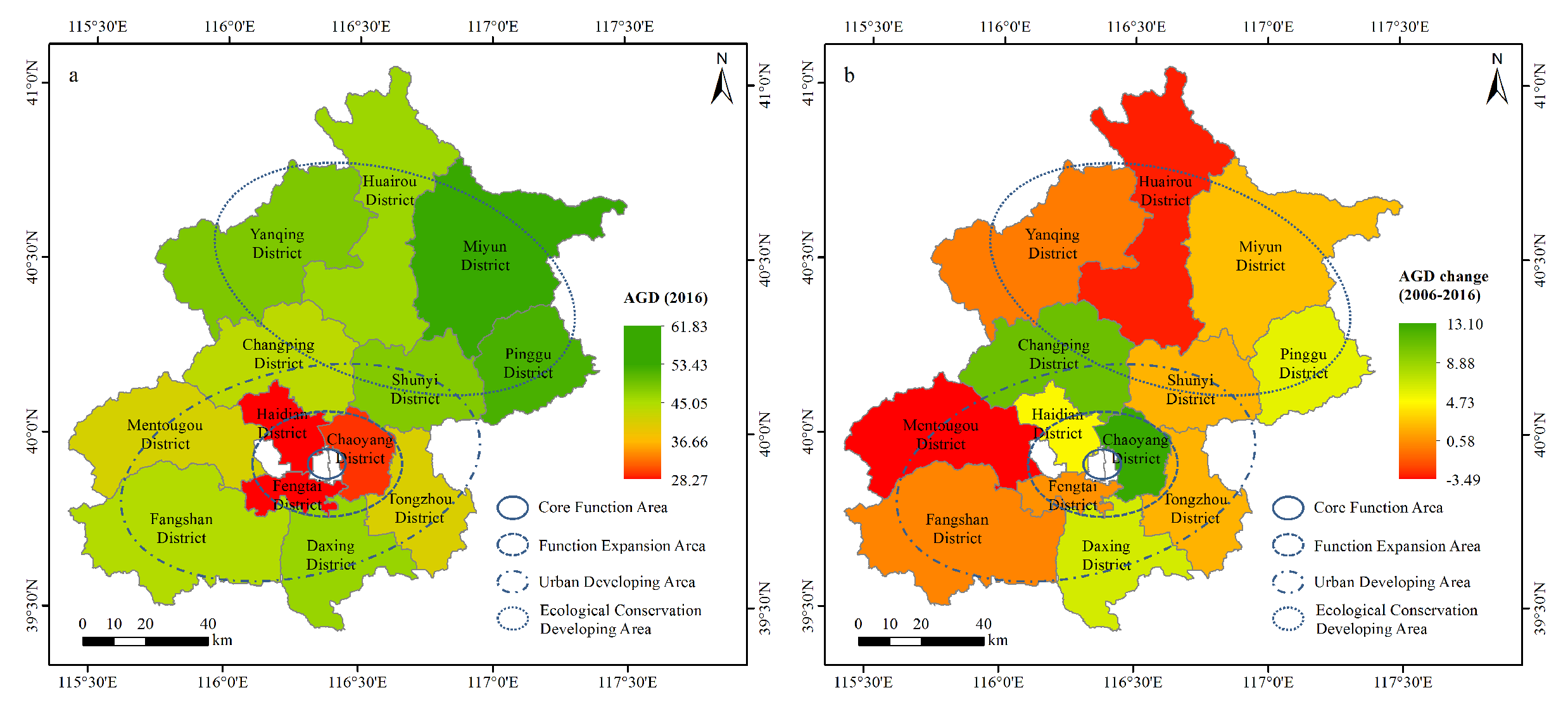
| Evaluation Layer | Index | Type | Unit | Weight Coefficient |
|---|---|---|---|---|
| Green agricultural production 2.08 | AP1: energy consumption per unit of gross agricultural output value | Negative | 1000 tons of standard coal/1000 yuan | 0.4220 |
| AP2: energy consumption per unit of arable land area | Negative | 1000 tons of standard coal/ha | 0.5329 | |
| AP3: fertilizer usage per unit of sown area | Negative | ton/ha | 0.2753 | |
| AP4: fertilizer usage per unit of gross agriculture output value | Negative | kg/1000 yuan | 0.1711 | |
| AP5: water consumption per unit of arable land area | Negative | ton/ha | 0.0169 | |
| AP6: water consumption per unit of gross agricultural output value | Negative | m3/1000 yuan | 0.2239 | |
| AP7: proportion of facility agriculture area in arable land area | Positive | % | 0.1530 | |
| AP8: arable land area per capita | Positive | Ha/capita | 0.2809 | |
| Green agricultural revenue 1.10 | AI1: proportion of agritourism revenue in gross agricultural output value | Positive | % | 0.0695 |
| AI2: proportion of seed industry revenue in gross agricultural output value | Positive | % | 0.2040 | |
| AI3: agricultural labor productivity | Positive | 1000 yuan/capita | 0.2314 | |
| AI4: agricultural output value per unit of arable land area | Positive | 10 million yuan/ha | 0.3428 | |
| AI5: proportion of fixed asset investment in rural areas | Positive | % | 0.2503 |
| Ranking | 1 | 2 | 3 | 4 | 5 | 6 |
|---|---|---|---|---|---|---|
| 2006 | AP7 (8.35) | AI1 (8.06) | AI3 (7.85) | AI2 (7.43) | AI4 (7.38) | AP3 (6.27) |
| 2007 | AP7 (8.50) | AI1 (8.05) | AI3 (7.82) | AI2 (7.58) | AI4 (7.38) | AP3 (6.87) |
| 2008 | AP7 (8.47) | AI1 (8.04) | AI3 (7.83) | AI2 (7.58) | AI4 (7.33) | AP3 (6.76) |
| 2009 | AI1 (8.13) | AP7 (8.07) | AI3 (7.84) | AI4 (7.25) | AI2 (7.16) | AP3 (6.76) |
| 2010 | AP7 (8.68) | AI1 (8.17) | AI3 (7.80) | AI2 (7.32) | AI4 (7.14) | AP3 (6.93) |
| 2011 | AP7 (9.02) | AI1 (8.36) | AI3 (7.80) | AI2 (7.75) | AI4 (6.96) | AP3 (6.49) |
| 2012 | AP7 (9.18) | AI1 (8.22) | AI3 (8.05) | AI2 (7.76) | AI4 (6.99) | AP5 (6.41) |
| 2013 | AP7 (9.57) | AI1 (8.21) | AI3 (8.10) | AI2 (7.71) | AP5 (7.67) | AP8 (6.46) |
| 2014 | AP7 (10.08) | AI3 (8.41) | AI1 (8.09) | AI2 (7.53) | AP5 (7.47) | AI4 (6.75) |
| 2015 | AP7 (10.74) | AP5 (8.43) | AI3 (8.32) | AI1 (8.31) | AI2 (7.62) | AP4 (7.10) |
| 2016 | AP7 (11.26) | AI3 (9.15) | AI1 (8.39) | AP5 (8.07) | AI2 (7.81) | AP4 (7.25) |
Disclaimer/Publisher’s Note: The statements, opinions and data contained in all publications are solely those of the individual author(s) and contributor(s) and not of MDPI and/or the editor(s). MDPI and/or the editor(s) disclaim responsibility for any injury to people or property resulting from any ideas, methods, instructions or products referred to in the content. |
© 2023 by the authors. Licensee MDPI, Basel, Switzerland. This article is an open access article distributed under the terms and conditions of the Creative Commons Attribution (CC BY) license (https://creativecommons.org/licenses/by/4.0/).
Share and Cite
Li, H.; Zhang, W.; Xiao, X.; Lun, F.; Sun, Y.; Sun, N. Temporal and Spatial Changes of Agriculture Green Development in Beijing’s Ecological Conservation Developing Areas from 2006 to 2016. Sustainability 2024, 16, 219. https://doi.org/10.3390/su16010219
Li H, Zhang W, Xiao X, Lun F, Sun Y, Sun N. Temporal and Spatial Changes of Agriculture Green Development in Beijing’s Ecological Conservation Developing Areas from 2006 to 2016. Sustainability. 2024; 16(1):219. https://doi.org/10.3390/su16010219
Chicago/Turabian StyleLi, Hong, Weiwei Zhang, Xiao Xiao, Fei Lun, Yifu Sun, and Na Sun. 2024. "Temporal and Spatial Changes of Agriculture Green Development in Beijing’s Ecological Conservation Developing Areas from 2006 to 2016" Sustainability 16, no. 1: 219. https://doi.org/10.3390/su16010219
APA StyleLi, H., Zhang, W., Xiao, X., Lun, F., Sun, Y., & Sun, N. (2024). Temporal and Spatial Changes of Agriculture Green Development in Beijing’s Ecological Conservation Developing Areas from 2006 to 2016. Sustainability, 16(1), 219. https://doi.org/10.3390/su16010219






